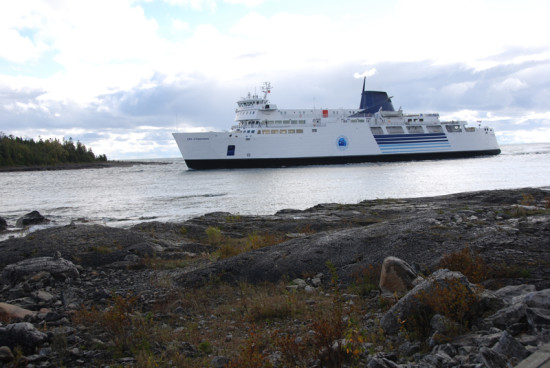OWEN SOUND—A study seeking to quantify the economic benefits of the MS Chi-Cheemaun ferry which links Manitoulin Island at South Baymouth to the Bruce Peninsula at Tobermory was recently released and is posted on the Owen Sound Transportation Company website at ontarioferries.com.
The study builds on an earlier released marketing study for the ferry service which sought to scout a pathway to turning around the ferry’s plummeting ridership numbers and which recommended that the ferry build itself into a tourism destination packaged with tourism offerings of Island tourism stakeholders.
The marketing study made it clear that the pathway to sustainability for the ferry service lies primarily in the tourism market and tapping into burgeoning markets in the Greater Toronto Area (GTA) where Manitoulin Island and the ferry have historically underperformed marketing-wise.
The benefits study, conducted by CPCS, the Canadian Pacific spinoff consulting company that researched and produced the marketing study, makes a compelling case for the importance the ferry plays in the economic well-being of Manitoulin Island and its environs.
The study followed two comparative streams in estimating the economic benefits the ferry provides to the Manitoulin economy—that of the status quo, a ferry service as currently provided by the OSTC, or that of no ferry service, where current travellers on the ferry must travel around Georgian Bay following Highway 400/69 through Sudbury.
Although the consultants were slightly hampered in their assessment by the fact that much of the available data through surveys did not differentiate between travellers to Sudbury and those ending their travels on Manitoulin, they were able to work around this shortcoming when they noted that postal code data indicated there was little significant travel to Sudbury via the ferry. Most travellers coming from the environs of the GTA travel up the Highway 400/69 route instead of taking the ferry, most of those to whom the ferry provides a strong travel benefit originate on the Bruce Peninsula itself.
The benefits study seeks to address six key questions in its assessment. 1.)What are the economic benefits associated with the operation of the ferry service itself? 2.)What are the local economic benefits resulting from ferry traffic, for example tourism? 3.)What are the travel time and cost benefits for ferry users? 4.)What are the road accident reduction benefits for ferry users? 5.)What are the environmental benefits associated with the ferry service, for example are there any reduced carbon dioxide emissions? And finally, 6.)what are other potential benefits associated with the ferry service?
In answering these questions two key elements come into focus. The first is the impact in terms of regional traffic reaching Tobermory and Manitoulin that drive local benefits and the second is based on the differences between the two scenarios in terms of vehicle kilometres travelled (VKT) and travel time for ferry riders—key to developing the rationale for travel cost savings, accident reductions and environmental benefits.
In terms of travel to the region, if no ferry service existed, the study estimates a reduction of traffic to the region between a best case low of 19 percent and a worst case high of 59 percent. In number terms, the study data suggests that drop from roughly 170,000 visitors to about 80,000 would occur under a high-impact result to a reduction of 30,000 visitors under a low-impact scenario. The thought of losing 30,000 visitors a year to the Manitoulin/Tobermory region would be enough to give most tourism stakeholders serious pause.
When it comes to the VKT assessment, the study indicates that the aggregate savings in travel for ferry riders adds up to roughly 11 million VKT per year. Added to that travellers between the Bruce Peninsula and Manitoulin save roughly 18,000 hours of travel time annually.
When it comes to economic benefits of the ferry operations there were three elements studied: the contribution to GDP of $3.3 million directly, $1.5 million indirectly and $1.8 million in induced benefits for a total of $7 million. In labour income, there were $4.6 million in direct benefits, $1 million in indirect benefits and $1.2 million in induced benefits for a total of $6.9 million. This equates to a total full-time equivalent jobs impact of 110 jobs.
Increased visitor spending associated with the ferry is estimated at between $4.8 million and $14.4 million per year. This additional spending leads to the creation of between 49 and 145 jobs and between $1.9 million and $5.5 million in annual labour income. The study estimates the regional gross domestic product impact as being between $2.9 million and $8.6 million per year.
In light of the ferry’s refocussing on tourists as the key to its sustainability plan the incremental impact of visitor spending on the local regional economy is expected to grow significantly with the passage of time—provided the campaign is successful in halting the decline in ferry ridership.
When it comes to reduced automobile operating costs, the study indicates the value of the 11 million VKT riders saved in 2012 were worth roughly $5.9 million. Reduced road accidents add further savings of $770,000.
While the study recognized the ‘experiential’ value of the ferry service, that travel decisions are adjusted due to the value travellers place on the experience of travelling by ferry as part of their journeys, the very subjective nature of assessing that value brought the consultants to the conclusion that they should not include those assessments in the benefits study. Overall, the study concluded that $7 million in reduced operating costs and travel time are linked to the ferry’s operations.
Sadly, no case could be made for the environmental benefits of travelling by ferry in reduced carbon emissions, as the ferry’s emissions exceed the savings in reduced rider VKT.
The study noted that the impact of the loss of the ferry service would most severely be felt by the South Baymouth community and would likely result in a portion of that community relocating to another region and an inevitable loss of services and falling property values would have a significant impact. Although the challenges of no ferry service would be felt throughout the Island, the heaviest blow would fall there.
The study concludes that the ferry contributes between 159 and 255 full-time jobs, between $9.2 million and $15.6 million in economic activity and between $8.8 million and $12.4 in labour income each year it operates. In addition to these impacts, the study conservatively values rider benefits at $7 million a year.





